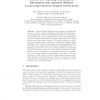Free Online Productivity Tools
i2Speak
i2Symbol
i2OCR
iTex2Img
iWeb2Print
iWeb2Shot
i2Type
iPdf2Split
iPdf2Merge
i2Bopomofo
i2Arabic
i2Style
i2Image
i2PDF
iLatex2Rtf
Sci2ools
81
Voted
BILDMED
2007
2007
Method for Projecting Functional 3D Information onto Anatomic Surfaces
Today the main challenge in cancer surgery is increasing the accuracy in tumor resections. Malignant cells must be completely removed, while harm to the surrounding healthy tissue must be minimized. An interesting idea to solve this problem is the use of nuclear-labeled cancer tracers and intraoperative navigated nuclear probes for residual control after minimal tumor resection. The idea is to produce an activity encoded surface, which localizes the radioactively marked residual malignant cells. The thus created surface map is consequently used to direct the surgeon during resection by means of augmented reality or by simulating a count-rate at the tip of a surgeon’s instrument improving the accuracy. However, there is a certain distance between the surface and the probe’s tip during the scan procedure. Moreover, the nuclear probe is not always positioned perpendicular to the surface. The main contribution of this work is to develop a data post-processing procedure that takes into ...
Related Content
| Added | 29 Oct 2010 |
| Updated | 29 Oct 2010 |
| Type | Conference |
| Year | 2007 |
| Where | BILDMED |
| Authors | Oleg Kishenkov, Thomas Wendler, Jörg Traub, Sibylle Ilse Ziegler, Nassir Navab |
Comments (0)

